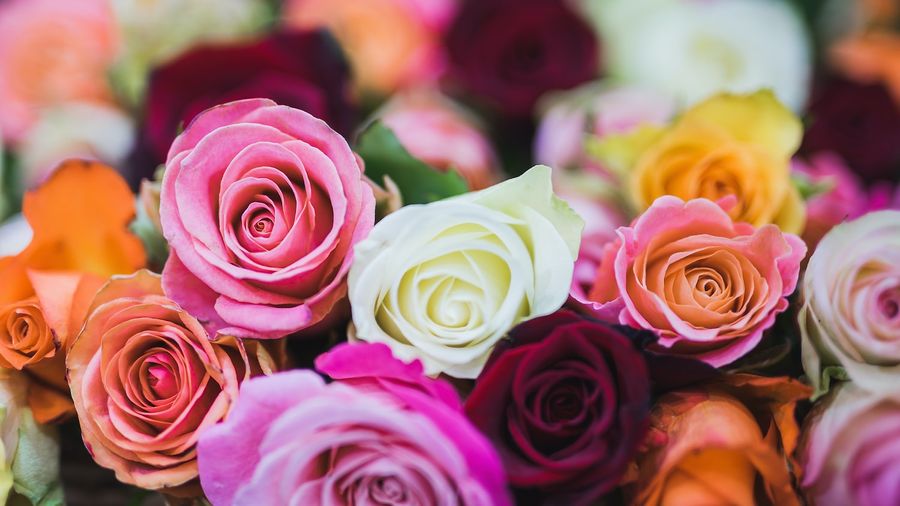· flowers · 5 min read
All About Roses
Roses are flowering shrubs that belong to the Rosa genus in the Rosaceae family.

They are grown from rose bushes, which produce blooms with distinctive layers of petals in various colors, sizes, and shapes. Roses can be propagated through seeds, cuttings or grafting onto rootstocks.
Cultivating roses requires patience, care, and a deep understanding of their needs. Roses thrive in well-drained soil, ample sunlight, and consistent watering. They are generally grown from either bare-root plants or potted roses. Pruning is essential to encourage healthy growth and blooming, while fertilization and pest control are integral to their overall well-being.
History of Roses
Roses have a rich and storied history dating back thousands of years. They have been cultivated and appreciated for their beauty and fragrance since ancient times. The cultivation of roses is believed to have originated in China around 5,000 years ago. From there, they spread to various parts of the world, including Persia, Greece, Rome, and eventually Europe.
Roses gained popularity during the Roman Empire, where they were used for various purposes, including ornamental gardens, perfumes, and medicinal remedies. They became particularly significant during the Renaissance and Victorian eras, symbolizing love, beauty, and luxury.
In art, literature, and poetry, roses have inspired countless works. From Shakespeare’s famous line, “A rose by any other name would smell as sweet,” to the romantic gestures of presenting a red rose as a token of love, these flowers have been the subject of countless expressions of affection and admiration.
Types of Roses
The world of roses boasts an astonishing array of varieties, each with its own distinctive characteristics. Some popular types include:
Hybrid Tea Roses
Known for their elegant, high-centered blooms, hybrid tea roses are often cultivated for their long, sturdy stems and captivating fragrance. They are prized for their versatility and are commonly used in floral arrangements.
Floribunda Roses
These roses produce abundant clusters of smaller blooms, providing a profusion of color throughout the season. Floribundas are known for their hardiness, making them a popular choice for gardeners.
Grandiflora Roses
A cross between hybrid teas and floribundas, grandiflora roses feature large, showy blooms carried in clusters. They often possess a delightful fragrance and make a striking addition to gardens or floral displays.
Climbing Roses
With their flexible canes, climbing roses gracefully ascend walls, trellises, or fences. They produce clusters of blooms and add a vertical dimension to landscapes, imbuing them with a sense of romance and beauty.
Miniature Roses
These compact roses, with their petite blooms resembling their larger counterparts, are perfect for container gardening or small garden spaces. Despite their small size, they exhibit the same grace and charm as larger roses.
Colors and Symbolism of Roses
The color palette of roses is equally diverse, with each hue carrying its own symbolism.
Roses are commonly found in:
Red
Red roses symbolize love, romance, and passion. They are the ultimate expression of deep affection and are often associated with classic and timeless love stories. Red roses are perfect for conveying intense emotions and are popular choices for anniversaries and Valentine’s Day.
Pink
Pink roses represent gentleness, admiration, and sweetness. They symbolize love, gratitude, and affectionate feelings. Light pink roses convey innocence and grace, while darker shades of pink can express appreciation and gratitude. Pink roses are often exchanged to celebrate friendships and express admiration.
White
White roses symbolize purity, innocence, and new beginnings. They are often associated with weddings and represent everlasting love and loyalty. White roses also convey a sense of reverence and can be used to honor and remember loved ones.
Yellow
Yellow roses symbolize friendship, joy, and new beginnings. They are bright and cheery flowers that represent optimism and happiness. Yellow roses are often given as a symbol of friendship or to celebrate achievements and milestones.
Orange
Orange roses symbolize enthusiasm, passion, and energy. They are vibrant and eye-catching, representing excitement and fascination. Orange roses are perfect for expressing intense desire and enthusiasm for someone or something.
Lavender
Lavender roses symbolize enchantment and love at first sight. They convey a sense of fascination and can be used to express feelings of adoration and love for someone special. Lavender roses are unique and carry an air of elegance and charm.
Bi-Colored
Bi-colored roses feature two or more colors, creating a visually striking effect. The specific color combinations can vary, offering a wide range of options. Bi-colored roses often represent unity, harmony, and balance. They are a perfect choice for celebrating diverse relationships or conveying a mix of emotions.
Fun Facts about Roses
There are over 150 species of wild roses found worldwide.
The world’s oldest living rose bush is believed to be over 1,000 years old and grows on the walls of the - Hildesheim Cathedral in Germany.
Rose hips, the fruit of the rose plant, are a rich source of vitamin C and are used to make herbal teas, jams, and skincare products.
The rose is the national flower of the United States and several other countries, including England, Bulgaria, and Iran.
Roses continue to be one of the most beloved and iconic flowers, admired for their beauty, fragrance, and symbolism. Whether used in gardens, floral arrangements, or as gifts, they hold a special place in human history and culture.